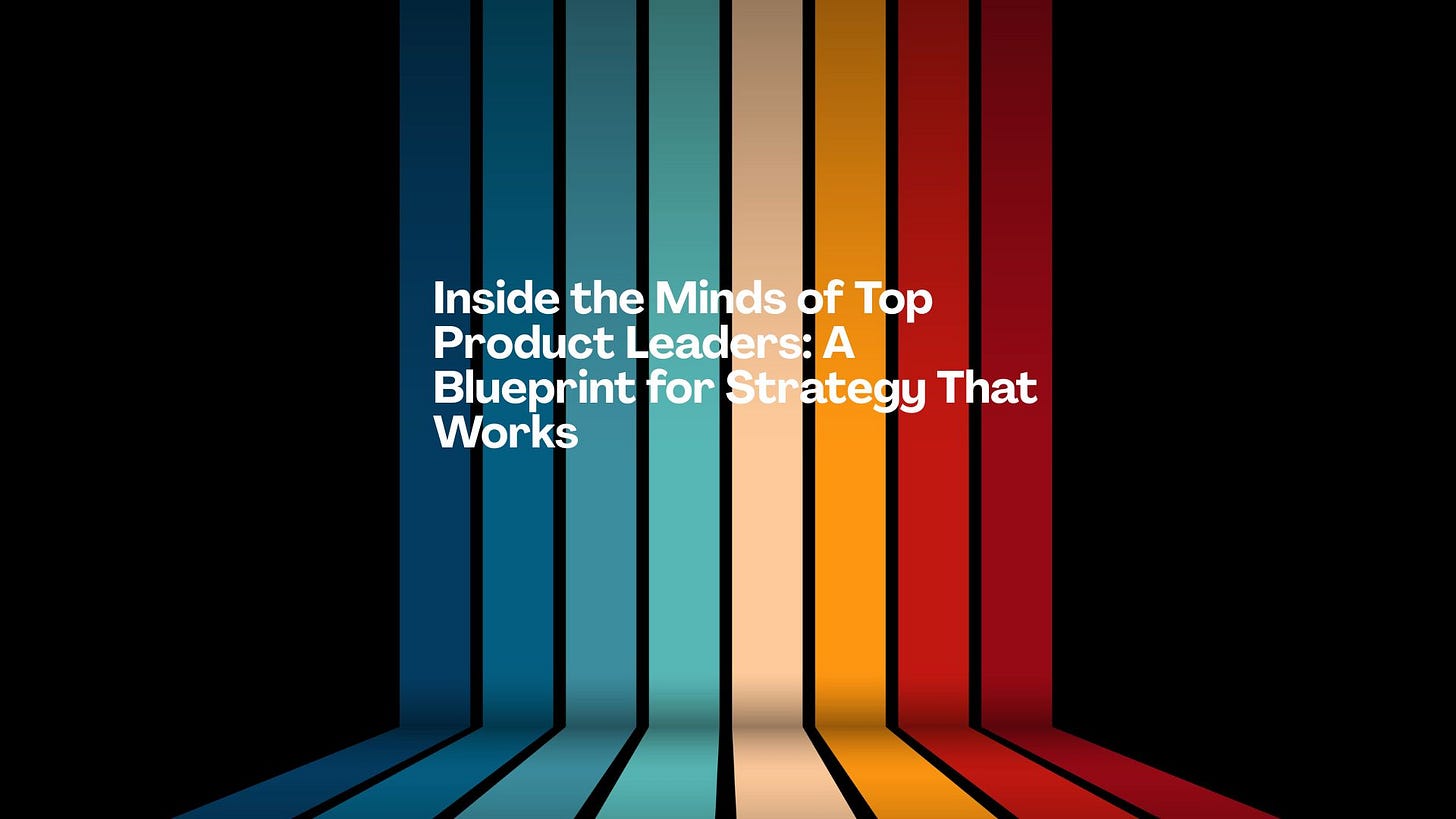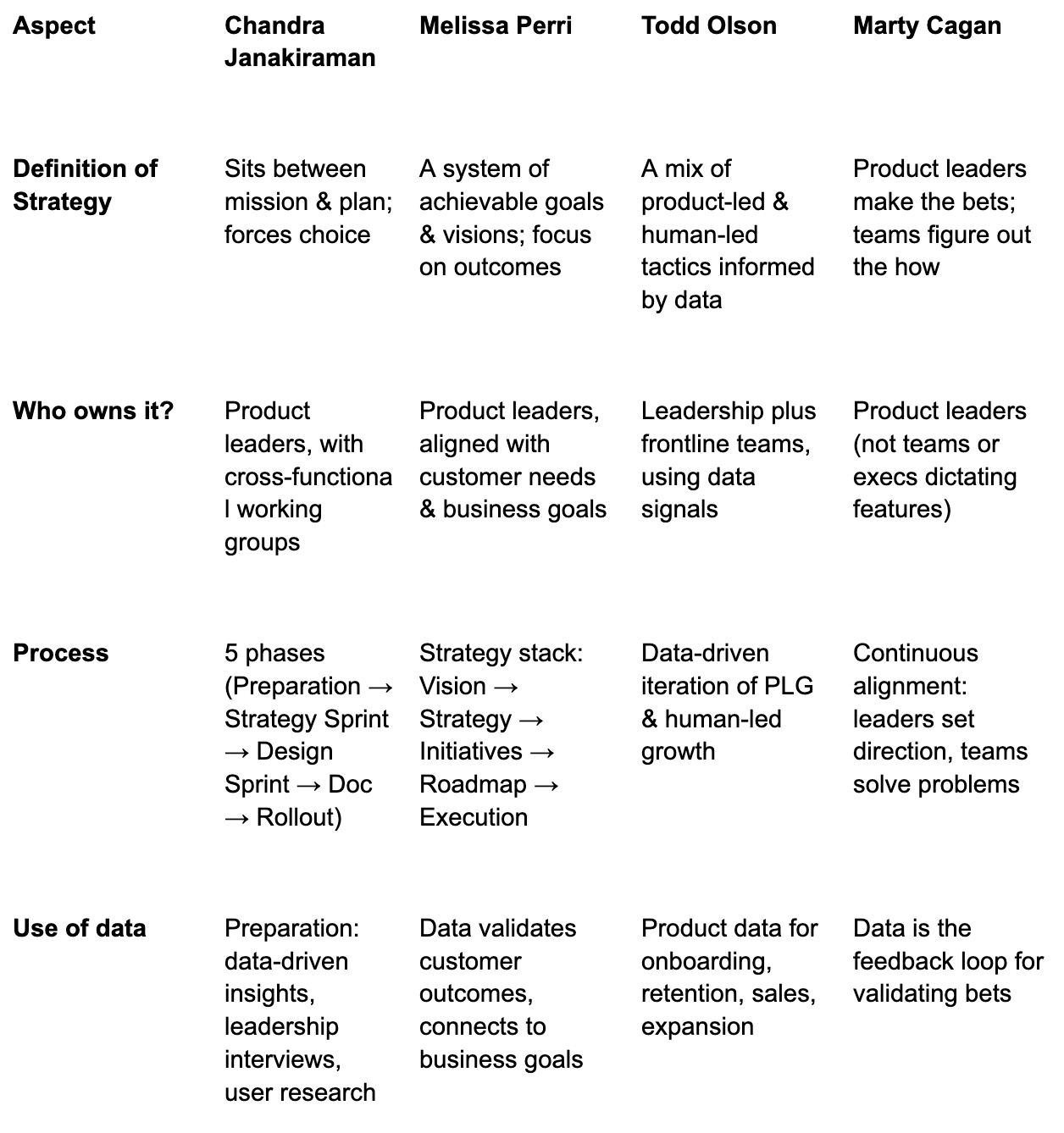Inside the Minds of Top Product Leaders: A Blueprint for Strategy That Works
How Great PMs Build Strategy That Wins
Product strategy is one of the most debated — and misunderstood — topics in the world of product leadership. Recently, I’ve been reflecting on the ideas shared by several accomplished product leaders:
Chandra Janakiraman (CPO at VRChat, ex-Headspace, Meta)
Todd Olson (CEO of Pendo, author of The Product-Led Organization)
Marty Cagan (Partner at SVPG, author of Inspired and Empowered)
Melissa Perri (CEO of Produx Labs, author of Escaping the Build Trap)
Each leader brings a unique perspective on what product strategy is, how to create it, and how to align it with execution. Let’s dive into their viewpoints, compare them, and uncover actionable lessons for today’s product leaders.
1. What is Product Strategy?
Across the board, these leaders agree on one thing: product strategy is not a roadmap of features.
Chandra defines it crisply:
“Product strategy sits between mission & vision and the plan or roadmap. It forces choices about where to invest and what to ignore, so you can generate maximum impact.”
Melissa Perri expands this with her classic definition:
“Product strategy is a system of achievable goals and visions that work together to align the team around outcomes.”
For Melissa, the key word is outcomes, not outputs (features) or tasks. This is aligned with Marty Cagan’s mantra:
“Product leaders do the product strategy. Teams figure out the best way to solve those problems.”
In other words:
Product leaders articulate the bets (the outcomes, the big problems).
Product teams figure out the how (the best way to achieve those outcomes).
2. The Role of Leadership: Top-Down, Bottom-Up, or Both?
Here’s where it gets nuanced:
Marty Cagan:
Empowerment is not about teams picking what to work on; it’s about leaders making strategic choices, then empowering teams to figure out how to win. He sees this as the antidote to “feature factory” teams — ensuring teams are solving real problems, not just building what’s on the roadmap.Melissa Perri:
She stresses the risk of the “build trap” — where teams become feature factories, cranking out outputs that don’t connect to a real strategy. Her solution? Clear product strategy that prioritizes outcomes over outputs. She says:
“Good product strategy bridges the gap between business goals and customer needs.”Todd Olson:
Adds the dimension of blending product-led growth (PLG) with human-led efforts. His view: product data should inform both self-service experiences and high-touch sales/support engagement.Chandra Janakiraman:
Offers a clear operational approach to building alignment: a 8-12 week, five-phase process that incorporates leadership interviews, working group collaboration, and a final “rollout” phase to align all stakeholders.
Key insight:
While these leaders might use different words, they converge on one idea: strategy must come from the top, but it’s not a mandate for features — it’s a mandate for outcomes. And it must be deeply informed by bottom-up signals (data, customer insights, frontline experimentation).
3. A Repeatable Process: Chandra’s 5 Phases & Melissa’s Strategy Stack
Chandra’s 5-phase process (Preparation → Strategy Sprint → Design Sprint → Document Writing → Rollout) offers a tactical playbook.
Melissa Perri, in Escaping the Build Trap, lays out a complementary framework she calls the Strategy Stack:
Vision – The long-term, aspirational future state
Product Strategy – The approach to achieve that vision in the medium term
Product Initiatives – The big bets or themes (often aligned with Chandra’s “strategic pillars”)
Product Roadmap – The features and milestones that bring those initiatives to life
Execution – The day-to-day build/learn/iterate cycle
Melissa’s stack emphasizes that product strategy is not the roadmap — it’s the layer above the roadmap. This is a perfect match to Chandra’s insistence that strategy is about “what not to focus on” as much as what to invest in.
4. The Role of Data: Todd Olson’s Product-Led Expansion
Todd Olson’s insights highlight the power of data to inform and refine product strategy continuously. In his talk, he shares how:
Product data identifies your “aha” moments for onboarding.
Usage patterns can identify “happiness markers” for retention.
Product-qualified leads (PQLs) can supercharge sales efforts.
Trials and in-product engagement inform future bets.
Melissa Perri reinforces this idea. She argues that data is essential to avoid the build trap. As she puts it:
“Without good data, you’re just guessing. You’re not making strategic choices; you’re gambling.”
Together, these views underscore that the best product strategies are living documents. They evolve with continuous feedback from customers, usage analytics, and market shifts.
5. Small “s” vs. Big “S” Strategy: Present-Forward and Future-Backward
Chandra’s distinction between:
Small “s” strategy – Near-term, problem-focused, 2-year horizon
Big “S” strategy – Long-term, aspirational, 5-10 year horizon
… echoes Melissa’s “vision” vs. “product strategy” layers. She notes that many teams confuse the vision (the big inspiring future) with the near-term product strategy (the best bets for now). Both are crucial, but they serve different roles.
Marty, too, highlights that good product leaders must balance short-term execution with long-term vision — otherwise, they risk either stagnation or pie-in-the-sky thinking.
6. Bringing it All Together: The Unified View
Here’s the synthesis of these leaders’ perspectives:
7. Key Takeaways for Product Leaders
Product strategy is a set of choices — not a roadmap. It’s about where to focus (and where not to).
It must be informed by data, but driven by leadership. Bottom-up signals are crucial, but they don’t replace top-down strategic thinking.
Empowerment = leaders set the bets, teams figure out the how. This avoids feature factories and creates truly empowered teams.
Avoid the build trap. As Melissa says, “Focus on outcomes, not outputs.”
Blend human and product-led motions. As Todd emphasizes, even in PLG, humans play a key role.
Think in both short and long-term. Big “S” vision fuels ambition; small “s” strategy makes it real.
The Craft of Strategy
Building great products isn’t just about shipping features — it’s about making clear, data-informed, customer-centered choices. It’s about uniting the top-down and bottom-up to find the sweet spot of alignment.
As these leaders show us, there’s no one “perfect” way to craft product strategy — but there is a common thread:
Clarity. Alignment. Outcomes.
If we can get that right, we’re well on our way to escaping the build trap, driving real impact, and building products that matter.
Research inspired by:
How to create a winning product strategy | Melissa Perri
Marty Cagan, SVPG - Product Discovery, Product Strategy & Empowered Product Teams - Product Faculty




